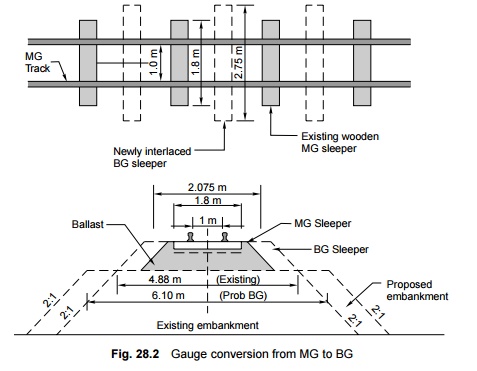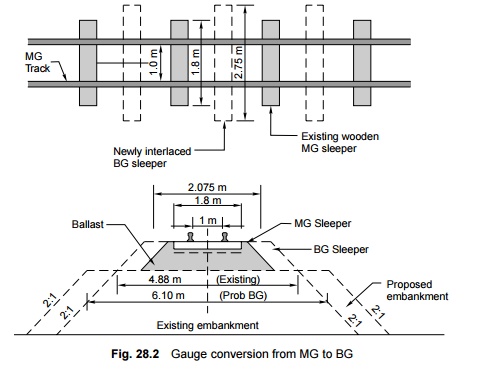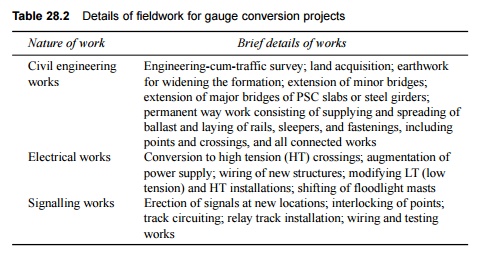Chapter: Civil : Railway Airport Harbour Engineering : Railway Engineering : Construction of New Railway Lines and Track Linking
Execution of Gauge Conversion Projects

A number of projects have recently been taken up by Indian Railways for converting railway lines from meter gauge to broad gauge. Gauge conversion projects (Fig. 28.2) basically aim at providing a uniform gauge for the smooth and fast flow of traffic, which may be necessitated either due to strategic reasons or on account of operating considerations.
The main advantages of gauge conversion as well as its details are discussed in Chapter 2.
Execution of Gauge Conversion Projects
Details of works The fieldwork normally involved in gauge conversion projects is presented in Table 28.2.


Planning of works Gauge conversion projects require detailed planning as they involve expansion, which needs to be carried out in a tight time schedule and multifarious activities such as assigning of contracts; posting and management of manpower, including supervisors and artisans, etc.; supply of track materials; and coordination between the engineering, service and telegraph, electrical, operating, and various other departments. Most of the engineering work is done by placing traffic blocks on a regular basis while the residual work is finally completed after placing an extended traffic block of several consecutive days on the route, during which time gauge conversion works are executed on a war footing.
Manpower requirement The manpower required for the various tasks involved in a gauge conversion project is to the tune of about 80 labourers per km to ensure that gauge conversion is completed within 30 days in all respects. One PWI and one AEN should be assigned for one- and two-block sections, respectively, for the continuous monitoring of the progressing work to ensure the requisite quality control. The contractor should also engage at least two competent supervisors per block section in addition to the trained permanent way mates appointed for each gang.
Speed potential Two rounds of packing by light off-track tampers such as phooltas or chinese tampers are required to make the track fit for a speed of 50 km/h. This is further supplemented by two more rounds of packing using heavy on-track tie tamping machines for making the track fit for a speed of 100 km/h.
Economy measures Gauge conversion projects are capital intensive and adequate financial resources have to be mobilized to meet these ambitious targets. The Railway Ministry has, therefore, taken a decision that all schemes of gauge conversion are to be carried out in the most economical way. By cutting down the cost of gauge conversion in various ways, the Railways plan to carry out gauge conversion works at an economical cost of Rs 6 to 7 million per km as against the normal cost of Rs 9 to 10 million per km, thereby saving about 30 to 40% on the initial cost. The guidelines to be followed in this regard are the following.
(a) The maximum permissible speed on the converted BG section need not be more than what was previously specified for the MG section.
(b) The facilities required at the stations should not be more than what has already been provided except that the loop length should be 686 m.
(c) The length of the platform at those stations that currently serve as stops for mail/express trains should be just enough for accommodating l6 coaches. If the existing platform needs to be extended, the extended portion should be constructed at rail level. On suburban sections, the length of the platform should be enough for 12 coaches. At important stations, the platform length should be sufficient for no more than 22 coaches with added provisions for future expansion to include 26 coaches.
Related Topics